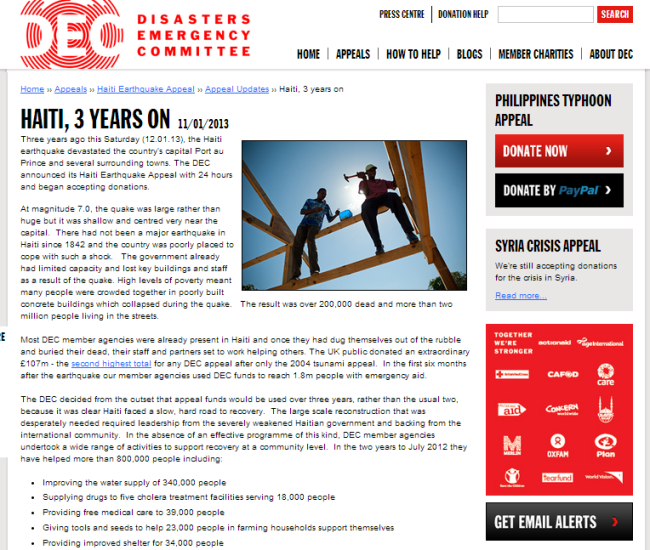This is the first of a two-part blog I’m writing about health and safety. It’s forty years since the UK’s Health and Safety at Work Act 1974 came into force. It, and subsequent legislation, has transformed all UK construction places, but has had a particular effect on construction sites.
Part 1: Construction safety & NGOs
We’ve all seen them: the proud photos in fundraising literature of people in disaster-stricken countries rebuilding with money from relief agencies. In bare feet or sandals, without gloves, balanced on the roof, young men are helping provide new houses, or a school, or a clinic. This is evidence of people being helped. It’s definitely a good thing.
But is it good enough?
Construction work is consistently amongst the most dangerous professions in the world. From the ILO[1]:
“In the construction industry, at least 60,000 people are fatally injured on building sites every year. Many hundreds of thousands more suffer serious injuries and ill health. In fact, these estimates are conservative. In many countries, less than 20 per cent of construction injuries are reported, and little account is taken of the longer-term impact of occupational diseases. The main causes of fatalities in the sector include falls, fatal crush injuries and the impact of falling objects, and electrocution. Major health problems range from deafness to vibration syndromes, back injuries, other musculoskeletal disorders, and exposure to hazardous substances (solvents, isocyanates, pesticides in timbers, chemical treatments for damp courses, fire retardants, welding fumes) and to dust and fibres (cement dust, silica, wood dust, fibreboard and, worst of all, asbestos). Stress is a frequent problem brought on by the other factors, notably the fear of falling. Construction workers tend to live away from home in substandard accommodation, especially in the developing countries. Tuberculosis, cholera, dengue, malaria and HIV/AIDS can therefore pose particular risks.”
The construction industry is dangerous everywhere. In the UK, which has world-leading health and safety practices, only agriculture and fisheries have a higher fatality rate, and the number of injuries and people suffering long-term ill effects is large[2]. The UK has strong legislation to protect construction workers. The Health and Safety Executive will prosecute breaches of legislation and workers are well insured and will be compensated if injured at work.
In most countries around the world this is not the case. Most construction workers are uninsured and cannot expect support if hurt because of doing their jobs. NGOs build quite a lot; they employ trades people and labourers all the time. Some NGOs build a huge amount, it’s pretty much what they do. In most cases (not all), the safety provisions they put in place for local labour are minimal. Rarely is decent footwear provided. Scaffolding, to allow safe working at height, is usually considered too expensive (and remember that falls are a leading killer). Training in safe working and good site management, which are totally free – are not often seen.
None of this would be acceptable in the rich countries in the north, but somehow it’s deemed too much trouble and expensive in poor countries. This while in countries with no social security systems, with no safety nets, the impact of an injury at work can be destitution for whole families.
If NGOs are serious about disaster risk reduction, perhaps they should start with reducing the very real risk of disaster to individuals working in construction by training them in safe construction methods and by providing them with safe working environments. I’m not suggesting we can achieve the very low accident rates of the UK; after all it’s taken the UK over 40 years of concerted effort to get there. But surely we can do much better, and we shouldn’t accept dangerous working practices just because the workers are poor?
The ILO has a code of practice for Safety & Health in Construction[3][4], which should ideally be followed, but there are some simple things NGOs should ensure are included in the budgets and project plans for all projects involving construction:
- Train workers in safe working practices.
- Provide, on loan, personal protective equipment (hard hats, gloves, high-visibility jackets, steel toe-capped boots, safety glasses).
- Ensure scaffolding is provided for all working above ground, or at least minimise working at height.
- Maintain a tidy site, to prevent trips and falls.
- Have access control for the site to keep children out, ensure nobody is below people working above (and to keep track of your stuff).
None of these are difficult, none are expensive. It would be out of the question not to provide them in the west. There’s no excuse for not providing them anywhere else.
———————————————————————————–
PS. It’s been said to me before that decent footwear is too expensive, and surely it’s not that important? This is what happens if your skin is exposed cement – I warn you, it’s not pleasant: http://www.hse.gov.uk/skin/images/cementburn.jpg
